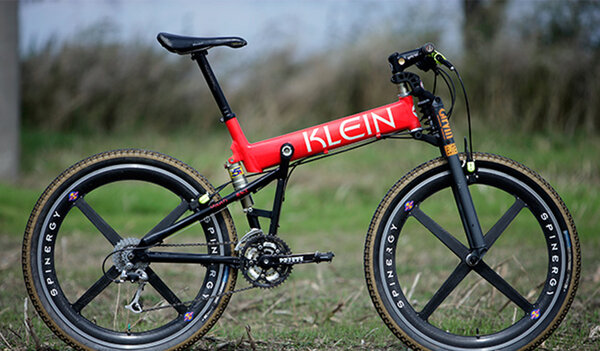Thias":dvq3v25m said:
I read that, too, about the rigid front. Gary said it in an interview. And it can be seen in early pictures. A guy in the german forum even built his mantra with a rigid strata fork and he seemed to like it.
one of the biggest is the fact that when you brake the head angle and seat angle greatly increased
This is the case with all rear suspension systems, not an URT-problem. I had s Schwinn "4banger" that had the same effect...
The only URT-inherent problems that I can think of, is the changing distance between the pedals and the seat. And the stiffening of the suspension while standing. But you will get used to the first one quickly. The second - well - don't go downhill too fast. :roll:
Fully active suspension bikes have brake squat that helps to preserve the correct head angle when braking and get the center of gravity low. As you brake, weight gets shifted to the handle bars and pedals. With a fully active suspension both rear and front shocks compress as you brake. Some bikes have anti-squat built in to the brake design to help keep the rear suspension from packing up when braking, but even those bikes will have some squat. (For some reason people sometimes call this brake jack). URTs have no brake squat, only brake jack.
The biggest issue I had with the URT was that it is not really full suspension. Since the BB is directly connected to the rear axle, that means only 2 of the 3 contact points are fully suspended from axle movement. And to make things worse, the only contact point that is able to get your center of gravity low is the one that is not full suspended making it much harder to get your weight low in situations when you want it as low as possible like braking, cornering or riding thru rough terrain. The further away the pivot is from the BB the worse it is as noted by terraplane bikes: "
The reason early URT designs were so bad was that they would place the pivot way up high. This meant that the bottom bracket would move an enormous amount as the suspension compressed, and this sucked for two reasons. One, you had a seat height that would change as the suspension compressed. Two, the suspension would only work when you were sitting down. This was advertised as a benefit, but in reality it was horrible. When was the last time you flew into a rock garden sitting down"
http://terraplanebikes.com/index/#/pocket-rocket/
Suspension bob was another big issue with URT designs. While the design did eliminate pedal feedback, in doing so you can't use the chain to create anti-squat to prevent the shock from compressing (bobbing) when you pedal. You can use dampening, but that makes the suspension less active. Fully active suspension bikes can use dampening or anti-squat or a combo of both for a much more active suspension. Also, pedaling is less efficient because your weight is shifting from the sprung part of the bike to the unsprung part when you pedal. Wikipedia does a better job of explaining than I could: "
as the URT's suspension moves, the distance between seat and pedals changes, detracting from pedaling efficiency. Furthermore, when the rider shifts any weight from the seat to the pedals, he or she is shifting weight from the sprung part of the bike to the unsprung parts. As such, part of their weight would not be suspended by the suspension system anymore. Since pedaling itself is a shift of this weight, the design is very prone to suspension bob."
The article from pinkbike is not the only one like that regarding URTs and the Klein mantra in particular. Here is another, but there are others:
https://dirtmountainbike.com/bike-revie ... er.html/14
So basically the URT eliminated pedal feedback from pedaling, but in doing so it;
-introduced trail feedback to the pedals because the BB is not fully
suspended from rear axle since it is directly connected to it
-increases pedal bob since there is no way to use anti squat to reduce
bob
-makes it so the distance from the bb to the seat is constantly changing
-does not fully suspend your feet from rear axle movement
-causes a "bucking" effect because the rear shock extends as you brake,
the head angle increases and the wheel base shortens
-forces you to keep your center of gravity as high as possible in order for
the suspension to work which is exactly the opposite of what you would
want to do in a situation when you need suspension most.
These are some of the reasons why almost no mtb manufacturer, other than department store brands, use this design anymore.

